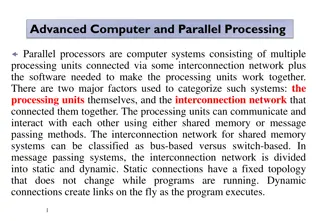SIMDRAM: An End-to-End Framework for Bit-Serial SIMD Processing Using DRAM
SIMDRAM introduces a novel framework for efficient computation in DRAM, aiming to overcome data movement bottlenecks. It emphasizes Processing-in-Memory (PIM) and Processing-using-Memory (PuM) paradigms to enhance processing capabilities within DRAM while minimizing architectural changes. The motiva
2 views • 14 slides
Parallel Processing and SIMD Architecture Overview
Parallel processors in advanced computer systems utilize multiple processing units connected through an interconnection network. This enables communication via shared memory or message passing methods. Multiprocessors offer increased speed and cost-effectiveness compared to single-processor systems
3 views • 24 slides
Optimizing DNN Pruning for Hardware Efficiency
Customizing deep neural network (DNN) pruning to maximize hardware parallelism can significantly reduce storage and computation costs. Techniques such as weight pruning, node pruning, and utilizing specific hardware types like GPUs are explored to enhance performance. However, drawbacks like increas
0 views • 27 slides
Managing DRAM Latency Divergence in Irregular GPGPU Applications
Addressing memory latency challenges in irregular GPGPU applications, this study explores techniques like warp-aware memory scheduling and GPU memory controller optimization to reduce DRAM latency divergence. The research delves into the impact of SIMD lanes, coalescers, and warp-aware scheduling on
0 views • 33 slides
Understanding SIMD for High-Performance Software Development
SIMD (Single Instruction Multiple Data) hardware support utilizes vector registers for high-performance computing. Vector instructions operate on multiple data elements simultaneously, offering scalability and efficient processing strategies. The use of wide vector registers enhances arithmetic oper
0 views • 41 slides
Exploring Hardware SIMD Parallelism Abstraction
Understanding the inherent parallelism in applications can lead to high performance with less effort, but the alignment with how Linux and C++ compilers discover parallelism is crucial. The shift towards making parallel computing more mainstream highlights the importance of SIMD operations and oppor
0 views • 50 slides
Implementation of Pupil Equity Funding at Lundavra Primary
Lundavra Primary in Fort William, opened in 2015, amalgamated from three schools, serves a diverse student population with 15% on free school meals and 19% living in SIMD 2 areas. The implementation process involves identifying gaps through data tracking, analyzing pupil equity data, and addressing
0 views • 15 slides
Introduction to OpenMP: A Parallel Programming API
OpenMP, an API for multi-threaded, shared memory parallelism, is supported by compilers like C/C++ and Fortran. It consists of compiler directives, runtime library resources, and environment variables. The history spans various specification versions, with features like tasks, SIMD, and memory model
0 views • 33 slides
Understanding Multi-Processing in Computer Architecture
Beginning in the mid-2000s, a shift towards multi-processing emerged due to limitations in uniprocessor performance gains. This led to the development of multiprocessors like multicore systems, enabling enhanced performance through parallel processing. The taxonomy of Flynn categories, including SIS
0 views • 46 slides
Understanding SIMD in Computer Architecture
SIMD (Single Instruction Multiple Data) architecture plays a crucial role in optimizing performance for parallel computing tasks. It allows for the simultaneous processing of multiple data elements, enhancing efficiency in various applications. The concept is rooted in executing the same operation a
0 views • 24 slides
Understanding Vector Programming and Machines
Vector programming involves efficient processing of data through SIMD models, parallel computing, and vector extensions in architectures like SSE and AVX. Programming vector machines in C requires addressing challenges with automatic vectorization related to pointers and data layouts.
0 views • 58 slides
Overview of Parallel Processing Architectures
This comprehensive overview delves into the taxonomy of parallel processor architectures, including SISD, SIMD, MISD, and MIMD configurations. It explores the characteristics of each architecture type, such as single vs. multiple instruction streams and data streams. The images provided visually rep
0 views • 76 slides
Exploring Overlay Architecture for Efficient Embedded Processing
The research delves into the implementation of overlay architecture for embedded processing, aiming to achieve optimal performance with minimal FPGA resource usage. It discusses motivations for utilizing FPGAs in embedded systems, the challenges of balancing performance and resource utilization, and
0 views • 24 slides
Flynn's Taxonomy: Classification of Computer Architectures
Michael Flynn's 1966 classification divides computer architectures into SISD, SIMD, MISD, and MIMD based on the number of instruction streams and data streams. SISD corresponds to traditional single-processor systems, SIMD involves multiple processors handling different data streams, MISD has multip
0 views • 10 slides













